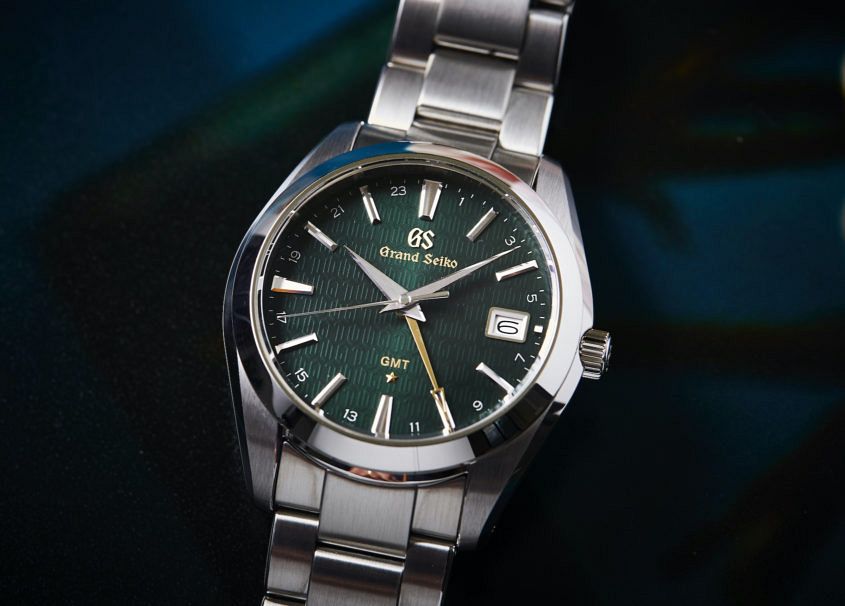INTRODUCING: The Seiko Presage Sharp Edged GMT Collection oozes robust elegance
 The force is strong with Seiko and it’s clear they are not holding back this year with some fantastic new releases. The Sharp Edged Presage collection is known for its robust elegance, featuring eye-catching dials in highly scratch and water-resistant cases. Previously we all had a plethora of dials to admire in the time and date format. For those who want a little more complication, Seiko has now introduced the Seiko Presage Sharp Edged GMT collection. The stainless-steel cases of the Seiko Presage Sharp Edged GMT collection are all 42.2mm in diameter, 13.7mm thick and a manageable 49.2mm lug-to-lug across the wrist. The sharp and angular geometry of the case is reminiscent of a creation from Grand Seiko, but with a level of finishing more in line with Seiko’s price point. The lug hoods are nicely satin brushed, with the caseband and outer squared facet of the lugs mirror polished. The contrasting finishes result in a sporty yet elegant timepiece that plays well with light. The cases are 100 metres water-resistant, which means you can safely explore all environments with the watch. And considering it is a GMT, you can utilise the 24-hour hand and black 24-hour bezel to keep…
The force is strong with Seiko and it’s clear they are not holding back this year with some fantastic new releases. The Sharp Edged Presage collection is known for its robust elegance, featuring eye-catching dials in highly scratch and water-resistant cases. Previously we all had a plethora of dials to admire in the time and date format. For those who want a little more complication, Seiko has now introduced the Seiko Presage Sharp Edged GMT collection. The stainless-steel cases of the Seiko Presage Sharp Edged GMT collection are all 42.2mm in diameter, 13.7mm thick and a manageable 49.2mm lug-to-lug across the wrist. The sharp and angular geometry of the case is reminiscent of a creation from Grand Seiko, but with a level of finishing more in line with Seiko’s price point. The lug hoods are nicely satin brushed, with the caseband and outer squared facet of the lugs mirror polished. The contrasting finishes result in a sporty yet elegant timepiece that plays well with light. The cases are 100 metres water-resistant, which means you can safely explore all environments with the watch. And considering it is a GMT, you can utilise the 24-hour hand and black 24-hour bezel to keep…
The post INTRODUCING: The Seiko Presage Sharp Edged GMT Collection oozes robust elegance appeared first on Time and Tide Watches.

 According to the Urban Dictionary, the definition of a baller is: “A person that makes shit happen. Without additional context, ‘baller’ typically is assumed to imply demonstrated ability in generating prodigious amounts of cash money, and/or a proficiency with creating frequent and mind-blowing sexual opportunities (note the non-gender specific reference, implying that ballers can be men or women, gay or straight — it is a matter of perspective).” If this be you, finding your wrist-match in our NOW magazine is a joyful experience, as even the smallest picture of any of these sparkly wrist-jewels will induce a Cheshire Cat grin. I’ll even start by cheekily suggesting a “womens” watch as an introduction as gender specifications are dying out, and frankly I want this particular AP for myself. Here are five killers from Vacheron Constantin, Audemars Piguet, Hublot and Louis Vuitton Audemars Piguet Royal Oak Concept Frosted Gold Flying Tourbillon Truth be told, if the glittering delight of the frosted gold and the nine-word designation of this tour de force from Audemars Piguet didn’t captivate you, we’ll book you an appointment with a psychiatrist. With its stippled gold surface and multi-tiered sunburst blue dial, this women’s Royal Oak Concept was nothing…
According to the Urban Dictionary, the definition of a baller is: “A person that makes shit happen. Without additional context, ‘baller’ typically is assumed to imply demonstrated ability in generating prodigious amounts of cash money, and/or a proficiency with creating frequent and mind-blowing sexual opportunities (note the non-gender specific reference, implying that ballers can be men or women, gay or straight — it is a matter of perspective).” If this be you, finding your wrist-match in our NOW magazine is a joyful experience, as even the smallest picture of any of these sparkly wrist-jewels will induce a Cheshire Cat grin. I’ll even start by cheekily suggesting a “womens” watch as an introduction as gender specifications are dying out, and frankly I want this particular AP for myself. Here are five killers from Vacheron Constantin, Audemars Piguet, Hublot and Louis Vuitton Audemars Piguet Royal Oak Concept Frosted Gold Flying Tourbillon Truth be told, if the glittering delight of the frosted gold and the nine-word designation of this tour de force from Audemars Piguet didn’t captivate you, we’ll book you an appointment with a psychiatrist. With its stippled gold surface and multi-tiered sunburst blue dial, this women’s Royal Oak Concept was nothing… Each of the models in the Rolex Professional series is a tool watch made for a man on a mission. While the Submariner and Sea-Dweller are diving watches, the Rolex Explorer II was originally built in 1971 for speleologists or cave explorers who required a sturdy, functional and highly legible watch while working in almost total darkness. Fortunately, it’s proven to be sufficiently versatile for other pursuits. The Rolex Explorer II Ref. 216570 is the model’s most recent incarnation and, if you know Rolex by their divers, you’ll be surprised by its no-nonsense toughness, instrument-like dial, and crisp black and white hand set. My favourite detail? That would have to be the big orange GMT arrow. The 42mm case is true to its size and, while the black dial version might slim it down a tad, the polar white dial here is intensely legible and perfectly balanced. There’s something alluring about the perfect whiteness of the dial surface which, with its chunky indices framed in black, works so well with the black Mercedes hands. It might all have been a bit too perfect and monochrome had it not been for the zingy EXPLORER II wording and GMT hand that are…
Each of the models in the Rolex Professional series is a tool watch made for a man on a mission. While the Submariner and Sea-Dweller are diving watches, the Rolex Explorer II was originally built in 1971 for speleologists or cave explorers who required a sturdy, functional and highly legible watch while working in almost total darkness. Fortunately, it’s proven to be sufficiently versatile for other pursuits. The Rolex Explorer II Ref. 216570 is the model’s most recent incarnation and, if you know Rolex by their divers, you’ll be surprised by its no-nonsense toughness, instrument-like dial, and crisp black and white hand set. My favourite detail? That would have to be the big orange GMT arrow. The 42mm case is true to its size and, while the black dial version might slim it down a tad, the polar white dial here is intensely legible and perfectly balanced. There’s something alluring about the perfect whiteness of the dial surface which, with its chunky indices framed in black, works so well with the black Mercedes hands. It might all have been a bit too perfect and monochrome had it not been for the zingy EXPLORER II wording and GMT hand that are… William Wood is known for their well built and accessibly priced timepieces, all of which are inspired by fire rescue and the brave people who put their lives on the line every day. We’ve covered the full backstory of the brand and its name before, but just to recap: William Wood was the name of brand founder Jonny Garrett’s late grandfather. For more than 25 years, William Wood served in the British Fire Service, winning commendations for his acts of bravery. Sadly, he passed away in 2009, but his legacy lives on through Jonny and the William Wood watch manufacture that upcycles rescue service materials into beautiful timepieces while donating to international firefighting charities. Today the William Wood collection expands further, introducing their first ever Swiss chronograph watches with the William Wood Triumph collection. Each of the new trio are inspired by the three elements required to start a fire: fuel, oxygen, and heat (seen below from left to right). The 316L stainless-steel case of each Triumph watch is 40.5mm in diameter, 15.5mm thick, and 100 metres water-resistant (admirable for a chronograph watch). The watch has a common lug width of 20mm, which means if for any reason you…
William Wood is known for their well built and accessibly priced timepieces, all of which are inspired by fire rescue and the brave people who put their lives on the line every day. We’ve covered the full backstory of the brand and its name before, but just to recap: William Wood was the name of brand founder Jonny Garrett’s late grandfather. For more than 25 years, William Wood served in the British Fire Service, winning commendations for his acts of bravery. Sadly, he passed away in 2009, but his legacy lives on through Jonny and the William Wood watch manufacture that upcycles rescue service materials into beautiful timepieces while donating to international firefighting charities. Today the William Wood collection expands further, introducing their first ever Swiss chronograph watches with the William Wood Triumph collection. Each of the new trio are inspired by the three elements required to start a fire: fuel, oxygen, and heat (seen below from left to right). The 316L stainless-steel case of each Triumph watch is 40.5mm in diameter, 15.5mm thick, and 100 metres water-resistant (admirable for a chronograph watch). The watch has a common lug width of 20mm, which means if for any reason you… Your first good watch is an important step in your watch collecting journey. It represents your first serious commitment to the hobby and probably the first time you spend an amount of money that most people would consider completely preposterous on a wristwatch. But because of that commitment, inevitably your first good watch will always be a memorable one in your collecting journey and represents the beginning of what is likely to be a headfirst dive into the weird and wonderful world of watch fanaticism. What was my first good watch? It was a choice that was off the beaten path, not because it wasn’t a great watch, but because it was quartz. That’s right, my first good watch was the Grand Seiko SBGN007. Why did I choose this instead of something that might have cost a similar amount, but was more traditional in the fact that it was a mechanical watch? Well, I knew at that point a decent proportion of the watches I’d bought were vintage Seikos, many of which were quartz, so I wasn’t starting from a position of only appreciating mechanical watches from Switzerland. The other reason was that for the cost of the Grand Seiko…
Your first good watch is an important step in your watch collecting journey. It represents your first serious commitment to the hobby and probably the first time you spend an amount of money that most people would consider completely preposterous on a wristwatch. But because of that commitment, inevitably your first good watch will always be a memorable one in your collecting journey and represents the beginning of what is likely to be a headfirst dive into the weird and wonderful world of watch fanaticism. What was my first good watch? It was a choice that was off the beaten path, not because it wasn’t a great watch, but because it was quartz. That’s right, my first good watch was the Grand Seiko SBGN007. Why did I choose this instead of something that might have cost a similar amount, but was more traditional in the fact that it was a mechanical watch? Well, I knew at that point a decent proportion of the watches I’d bought were vintage Seikos, many of which were quartz, so I wasn’t starting from a position of only appreciating mechanical watches from Switzerland. The other reason was that for the cost of the Grand Seiko… You’ll notice I wrote “tool watch” in the headline and will undoubtedly be challenged on this on two counts, so I’ll address them before the temperature rises. Because the Rolex Professional range does indeed consist of archetypal tool watches, no matter their value and luxurious status. We all know the other two greats, but both the Submariner and Sea-Dweller’s impressive tool-stats are often forgotten due to the brand’s high-end standing. The fact that they also fit very well under a suit jacket doesn’t help, but they are still rugged tool watches at heart, believe me. The Explorer II on the other hand, is refreshingly simple and a tad more casual. With it’s brushed case and no nonsense steel bezel, it’s unashamed of its purpose, and that is one of Exploration. If you don’t know Rolex that well you might be a little surprised by its no-nonsense austere look, detailed instrument-like dial, and very un-premium white tool hand set. And, of course, my favourite detail, that massive orange arrow the size of a racket. What’s behind that gigantic GMT arrow? It’s there because the original Explorer II, released in 1971, was aimed specifically for speleologists or cave divers, so maybe it…
You’ll notice I wrote “tool watch” in the headline and will undoubtedly be challenged on this on two counts, so I’ll address them before the temperature rises. Because the Rolex Professional range does indeed consist of archetypal tool watches, no matter their value and luxurious status. We all know the other two greats, but both the Submariner and Sea-Dweller’s impressive tool-stats are often forgotten due to the brand’s high-end standing. The fact that they also fit very well under a suit jacket doesn’t help, but they are still rugged tool watches at heart, believe me. The Explorer II on the other hand, is refreshingly simple and a tad more casual. With it’s brushed case and no nonsense steel bezel, it’s unashamed of its purpose, and that is one of Exploration. If you don’t know Rolex that well you might be a little surprised by its no-nonsense austere look, detailed instrument-like dial, and very un-premium white tool hand set. And, of course, my favourite detail, that massive orange arrow the size of a racket. What’s behind that gigantic GMT arrow? It’s there because the original Explorer II, released in 1971, was aimed specifically for speleologists or cave divers, so maybe it… Two-tone watches were all the rage in the 90s, but today many collectors have shunned the configuration out of fear they will look like Jordan Belfort. But not all two-tone is created equal, and Rolex has came up with a more youthful interpretation. The Rolex GMT Master II 126711CHNR Rootbeer is a modern take on two-tone, blending Everose gold and 904L stainless steel to create something you would have never seen in two-tone’s hey-day. The black and brown ceramic bezel creates a really interesting tone, the brown ceramic akin to a cup of coffee with a touch of milk. The 40mm case is still of the maxi era, which benefits its design as the modern lug stance distances the watch from two-tone creations of yesteryear. While it incorporates precious metal into its build, the Rolex GMT Master II 126711CHNR Rootbeer is every bit as robust as its full steel brethren. It is Trip-Lock secured with 100 metres water resistance and an Everose screw-down crown. As its proprietary blend name suggests, the rose gold is created never to lose its luster and shine – even over the course of active wear. While not as scratch-resistant as rhodium flashed white gold, rose…
Two-tone watches were all the rage in the 90s, but today many collectors have shunned the configuration out of fear they will look like Jordan Belfort. But not all two-tone is created equal, and Rolex has came up with a more youthful interpretation. The Rolex GMT Master II 126711CHNR Rootbeer is a modern take on two-tone, blending Everose gold and 904L stainless steel to create something you would have never seen in two-tone’s hey-day. The black and brown ceramic bezel creates a really interesting tone, the brown ceramic akin to a cup of coffee with a touch of milk. The 40mm case is still of the maxi era, which benefits its design as the modern lug stance distances the watch from two-tone creations of yesteryear. While it incorporates precious metal into its build, the Rolex GMT Master II 126711CHNR Rootbeer is every bit as robust as its full steel brethren. It is Trip-Lock secured with 100 metres water resistance and an Everose screw-down crown. As its proprietary blend name suggests, the rose gold is created never to lose its luster and shine – even over the course of active wear. While not as scratch-resistant as rhodium flashed white gold, rose… As a hobby, watch collecting is often full of little surprises. When it comes to the resale value of a watch, I can get a little obsessed. Part of the fun for me is chasing down the best bargain, trying to figure out what it’s worth, and wondering whether or not I’d be able to make my money back if I end up selling something down the line. While most people, correctly, say that watch collecting should never be about monetary investment, I can’t help but get a little spark of joy when I see the value of something I own creeping up over time. This story was originally going to be about “one that got away” — a watch I sold too soon — but a quick bit of research actually revealed that I got quite lucky in the case of a King Seiko 5626-7000. Now, to be clear, I have never bought a watch purely to sell it. As much as I get excited by the money aspect, I’ve only ever bought them because I’ve wanted to wear them, and selling them on only happens when I feel like that initial attachment has worn off. I don’t have…
As a hobby, watch collecting is often full of little surprises. When it comes to the resale value of a watch, I can get a little obsessed. Part of the fun for me is chasing down the best bargain, trying to figure out what it’s worth, and wondering whether or not I’d be able to make my money back if I end up selling something down the line. While most people, correctly, say that watch collecting should never be about monetary investment, I can’t help but get a little spark of joy when I see the value of something I own creeping up over time. This story was originally going to be about “one that got away” — a watch I sold too soon — but a quick bit of research actually revealed that I got quite lucky in the case of a King Seiko 5626-7000. Now, to be clear, I have never bought a watch purely to sell it. As much as I get excited by the money aspect, I’ve only ever bought them because I’ve wanted to wear them, and selling them on only happens when I feel like that initial attachment has worn off. I don’t have… Just when we had finally sussed out the design language of Moser they have another ace up their sleeve and it seems to be a very big sleeve indeed. The H.Moser & Cie Streamliner Flyback Chronograph still feels new, even after being out for almost a year and, with its timeless vibe, I suspect that’ll still be the case after many years, especially with this new and alluring dial. While the holy trinity of legacy brands tweak their tried and tested icons by a millimetre or two, that safe path is not for Edouard Meylan, CEO of H. Moser. This is a marked difference to what we’re used to seeing, especially in the hotly contested integrated bracelet category. But I think that’s exactly what we need. Here, instead of homage, we have retro futurism inspired by the streamlined designs of 1920s trains and cars, delivered in a fresh and innovative way. The H.Moser & Cie Streamliner Flyback Chronograph is a reference for which the word “curvilinear” seems to fit. Angular is not a term Moser needs to express themselves, and this is one of the distinct details that sets them apart. Images will not prepare you for the firm yet…
Just when we had finally sussed out the design language of Moser they have another ace up their sleeve and it seems to be a very big sleeve indeed. The H.Moser & Cie Streamliner Flyback Chronograph still feels new, even after being out for almost a year and, with its timeless vibe, I suspect that’ll still be the case after many years, especially with this new and alluring dial. While the holy trinity of legacy brands tweak their tried and tested icons by a millimetre or two, that safe path is not for Edouard Meylan, CEO of H. Moser. This is a marked difference to what we’re used to seeing, especially in the hotly contested integrated bracelet category. But I think that’s exactly what we need. Here, instead of homage, we have retro futurism inspired by the streamlined designs of 1920s trains and cars, delivered in a fresh and innovative way. The H.Moser & Cie Streamliner Flyback Chronograph is a reference for which the word “curvilinear” seems to fit. Angular is not a term Moser needs to express themselves, and this is one of the distinct details that sets them apart. Images will not prepare you for the firm yet…